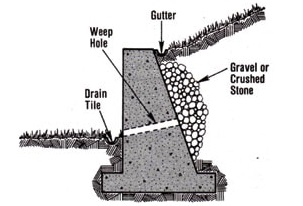Water accumulating within the side of the retaining wall can place stress on its structural integrity. If the overturning movement caused by the increased water pressure is more than the resisting vertical forces of the retaining wall, it will collapse. To address this weep hole is used.
These are small openings that are in a circular or rectangular shape used in retaining walls to drain excess water introduced into the structure by capillarity, leakage, or infiltration. It is usually provided with the help of sand drainage channels that allow them to function properly. The main function of the weep hole is to relieve the hydrostatic pressure acting on the retaining wall. They also prevent moisture from becoming trapped in the walls. For ventilation, weep holes enable air to reach the back of the wall inside the wall cavity. It also helps reduce the occurrence of dry rot and dampness that typically builds up when moisture enters an unventilated space.
When are weep holes needed in retaining walls?
If you are building a retaining wall structure below the water table then there is excessive water pressure on the wall structure, you need a weep hole. This additional hydrostatic pressure can be reduced by providing weep holes at the bottom of these structures. The weep holes are placed in the bottom of the retaining walls. “This is to prevent excessive pressure affecting the integrity of the retaining wall,” comments Ruban Selvanayagam of Property Solvers Off Market in the UK.

Their dimensions need to be carefully designed to control surface tension. The number of weep holes that need to be installed in a retaining wall structure depends on the maximum possible height of water accumulation or natural ground water table.
Advantages of Weep holes in Retaining Walls
- Allow water to drain from the water lodge on the retaining wall
- Remove hydrostatic pressure developed due to water lodge
- Prevent damage and dampness
- Helps moisture control
- Provide ventilation of the internal wall cavity

Types of Weep holes in Retaining Walls
Open Head Joint Weep Holes
These head joints are spaced at regular intervals at the base of the cavity wall and are the easiest type of weep hole to construct. They are placed in the upper wall joint to drain water only from that point. These are also quite effective in vapourising water from the cavities. For this type of weep hole, a plastic drainage structure is also provided around the drainage holes to prevent rain and inserts from entering the holes.
Cotton Rope Wicking Weep Holes
These weep holes are created using ropes that are less than 12 inches long. One end of the rope is placed at the joint and the other end extends to the cavity wall. The water from the back of the wall is absorbed by the cotton and on the other side, it gets evaporated.
Tubes Weep Holes
The tubes in the weep holes tubes are created using hollow plastic or metal tubes [spaced around 16 inches from each other]. The drain of the pipe is installed at a slight angle to facilitate the flow of water through the pipe.
Corrugated Channel Weep Holes
These types of weep holes help to quickly drain off water from the multiple channels. It is installed at the bottom side of the bed joint of the mortar.
Conclusion
A retaining wall weep hole is a passage for water to escape a building envelope. Weep holes serve an important purpose in a building. The primary function of these Weep Holes is to provide ventilation for the internal cavity walls and prevent them from water damage. Discussed above are different types of Weep Holes available; you can choose any of them that best matches your needs.

